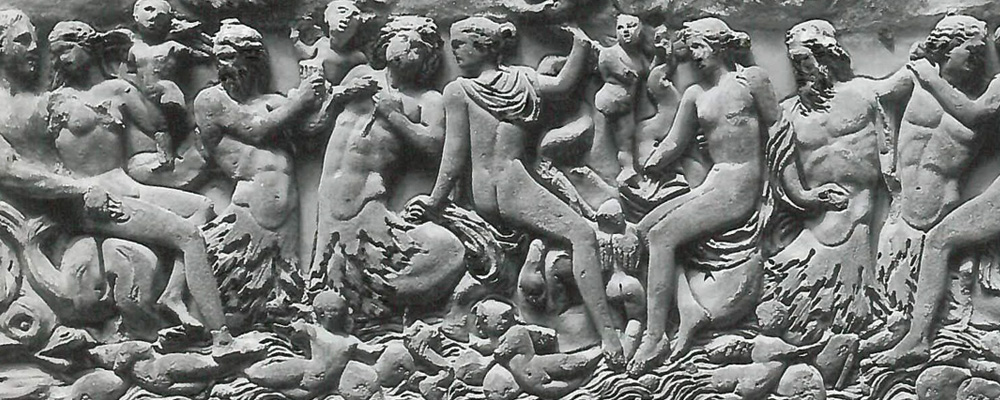
Subjects and Themes
Even today we think of the world beneath the waves as a tranquil place. Sea sarcophagi showed scenes of various fantastical ocean dwellers packed together in erotically charged, loving, and peaceful arrangements. Sarcophagi depicting these mythological sea creatures are often tightly packed with various water hybrids and ocean dwelling characters (Figure 9, Detail A). Mythical creatures like Nereids, Tritons, and other sea monsters were part of a longer tradition of mythological depiction. The daughters of Nereus, sea creatures themselves, usually appeared in the context of specific narratives.[1] They show couples embracing with Erotes playing about in the currents (Figure 1).


Around the archaic and classical periods, sea-dwelling beings were related to narratives and included in a particular mythological contexts. This connection to a narrative slowly faded and the depiction of carefree couples and imagery of pleasure became the primary subject. The formerly frightening sea monsters are no longer threatening. Ancient sculptors enjoyed inventing new hybrids for these blissful underwater scenes. Combinations of hybrids included horses, bulls, panthers, and rams all with fish tails. The sea-maidens, or Nereids, would behave friendly and flirtatiously toward these beasts, showing the playfulness and jovial nature of the scene (Figure 2). The older Tritons had long beards while the younger ones had unique faces, similar to those of depictions of barbarians during this period. Sea centaurs were also seen in these types of compositions. Monsters, centaurs, and Tritons changed into beloved companions (Figure 3).


Tritons, sea monsters, and Nereids were shown not only embracing each other but also playing musical instruments. The choirs of melodic voices and the light use of instruments create a feeling of ease and idyllic circumstances (Figure 4).[2] The music coming from these scenes greatly contrast the music of Bacchic celebrations. Another motif used to create an idyllic moment is the inclusion of happy families. Small infants can be seen held by their sea-monster fathers and embraced by their Nereid mothers (Figures 5, 6). This image of a pleasant family evokes a warm familial love in addition to the erotic love shown in the rest of the compositions.[3]


There is a gentleness to the movement of the pairings and couples in the calm waves. The peaceful and erotic mood is the subject of the composition in and of itself. Often one or more of the deceased were included in the scene through a portrait. Rather than being part of the scene, the deceased was shown framed in the center of the composition separate from the main composition (Figures 7, 8). The blissful circumstances were what people wanted to convey rather than a particular myth.[4] These soothing moments brought about happy memories and eased pain in the viewer’s mind.


Examples

This sarcophagus dating from the middle of the second century AD is currently on display at the Museo Nazionale Romano in Rome. Its composition is typical for the Beneath the Waves theme (Figure 9). The figures are packed together and coupled. Swirling engravings along the bottom of the sarcophagus represent the currents of the ocean. The Nereids sit on the laps and fish tails of the Tritons while small Erotes flutter about, emphasizing the love and lust within this scene. The smoothness of the Nereids’ bodies in contrast to the scaly skin of the sea monsters was emphasized to add to the erotic charge of the composition.[5]

A sarcophagus also dating from the middle of the second century AD and on display at the Museo Nazionale Romano in Rome shows Nereids riding on the backs of sea centaurs (Figure 10). The currents flow beneath them and winged Erotes fly above. Small dolphins can also be made out among the waves. Here the sea centaurs play and hold various musical instruments while the Nereids lounge about holding on to their billowing drapery. These intruments include a shell trumpet, a double flute, and a lyre. The Erotes hold torches and are draping garlands around the Nereids.

This final sarcophagus shows an example of a framed portrait of the deceased. The sarcophagus dates from circa 240 AD and is currently on display at the National Archaeological Museum in Naples (Figure 11). The face itself has been left rough to be filled in later by the patron. The deceased’s frame is being held up by two Tritons on either side and a small Eros below. The Tritons are both gazing into the eyes of their Nereid partners. Two other couples flank the center pairs. These two Nereids play string instruments, similar to the one that the deceased is playing. The comparison between the musical talents of the Nereids and those of the deceased are emphasized in this way – praising both the deceased’s beauty and talent.[6]
[1] Paul Zanker and Bjon Ewald, Living with Myths: The Imagery of Roman Sarcophagi, trans. Julia Slater (Oxford University Press, 2012), 113
[2] Ibid., 116
[3] Ibid., 119
[4] Ibid., 116
[5] Ibid., 115
[6] Ibid.